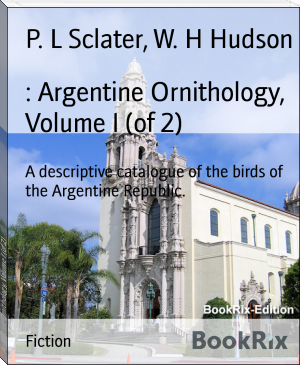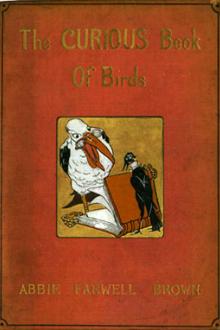: Argentine Ornithology, Volume I (of 2), P. L Sclater, W. H Hudson [best authors to read txt] 📗

- Author: P. L Sclater, W. H Hudson
Book online «: Argentine Ornithology, Volume I (of 2), P. L Sclater, W. H Hudson [best authors to read txt] 📗». Author P. L Sclater, W. H Hudson
in different situations.
On arriving in spring each pair takes up its position on some tree,
and usually on a particular branch; a dead branch extending beyond the
foliage is a favourite perch. Here they spend much of their time, never
appearing to remain long absent from it, and often, when singing their
notes together, fluttering about it with a tremulous uncertain flight,
like that of a hovering butterfly. About three weeks after first
arriving they begin to make advances towards the Oven-bird's nest that
stands on the nearest post or tree; and if it be still occupied by the
rightful owners, after much time has been spent in sporting about and
reconnoitring it, a feud begins which is often exceedingly violent and
protracted for many days.
In seasons favourable to them the Oven-birds build in autumn and winter,
and breed early in spring; so that their broods are out of their
clay-houses by the end of October or earlier; when this happens, the
Swallow that breeds in November quietly takes possession of the forsaken
fortress. But accidents will happen, even to the wonderful fabric of
the Oven-bird. It is sometimes destroyed and must be rebuilt; or its
completion has perhaps been retarded for months by drought, or by the
poor condition of the birds in severe weather; or the first brood has
perhaps perished, destroyed by an opossum or other enemy. November, and
even December, may thus arrive before some pairs have hatched their
eggs; and it is these unfortunate late breeders that suffer from the
violence of the marauding Swallows. I have often witnessed the wars of
these birds with the deepest interest; and in many ovens that I have
opened I have found the eggs of the Oven-birds buried under the nests
of the Swallows. After the Swallows have taken up a position near
the coveted oven, they occasionally fly towards and hover about it,
returning again to their stand. By-and-by, instead of returning as at
first, they take to alighting at the entrance of the coveted home; this
is a sort of declaration of war, and marks the beginning of hostilities.
The Oven-birds, full of alarm and anger, rush upon and repel them as
often as they approach; they retire before this furious onset, but not
discomfited, and only warbling out their gay seemingly derisive notes in
answer to the outrageous indignant screams of their enemies. Soon they
return; the scene is repeated; and this desultory skirmishing is often
continued for many days.
But at length the lawless invaders, grown bolder, and familiar with his
strength and resources, will no longer fly from the master of the house;
desperate struggles now frequently take place at the entrance, the birds
again and again dropping to the ground clutched fiercely together, and
again hurrying up only to resume the combat. Victory at last declares
itself for the aggressors, and they busy themselves carrying in
materials for their nest, screaming their jubilant notes all the time
as if in token of triumph. The brave and industrious Oven-birds,
dispossessed of their home, retire to spend their childless summer
together, for the male and female never separate; and when the autumn
rains have supplied them with wet clay, and the sense of defeat is worn
off, they cheerfully begin their building-operations afresh.
This is not, however, the invariable result of the conflict. To the
superior swiftness of the Martin the Oven-bird opposes greater strength,
and, it might be added, a greater degree of zeal and fury than can
animate its adversary. The contest is thus nearly an equal one; and the
Oven-bird, particularly when its young are already hatched, is often
able to maintain its own. But the Martins never suffer defeat; for, when
unable to take the citadel by storm, they fall back on their dribbling
system of warfare, which they keep up till the young birds leave the
nest, when they take possession before it has grown cold.
The Martin makes its own nest chiefly of large feathers, and lays four
eggs, long, pointed, and pure white.
It will be remarked that in all its habits above mentioned this bird
differs widely from the two preceding species. It also differs greatly
from them in its manner of flight. The Purple Martins move with
surprising grace and celerity, the wings extended to their utmost; they
also love to sail in circles high up in the air, or about the summits of
tall trees, and particularly during a high wind. At such times several
individuals are usually seen together, and all seem striving to outvie
each other in the beauty of their evolutions.
The Tree-Martin is never seen to soar about in circles; and though when
hawking after flies and moths it sweeps the surface of the grass with
amazing swiftness, at other times it has a flight strangely slow and of
a fashion peculiar to itself: the long wings are depressed as much as
those of a Wild Duck when dropping on to the water, and are constantly
agitated with tremulous flutterings, short and rapid as those of a
butterfly.
Neither is this bird gregarious like all its congeners, though
occasionally an individual associates for a while with Swallows of
another species; but this only when they are resting on fences or trees,
for as soon as they take flight it leaves them. Once or twice, when for
some mysterious cause the autumnal migration has been delayed long past
its usual time, I have seen them unite in small flocks; but this is very
rare. As a rule they have no meetings preparatory to migration, but
skim about the fields and open plains in un-Swallow-like solitude, and
suddenly disappear without having warned us of their intended
departure.
28. PETROCHELIDON PYRRHONOTA (Vieill.). (RED-BACKED ROCK-MARTIN.)
+Petrochelidon pyrrhonota+, _Scl. et Salv. Nomencl._ p. 14; _Durnford,
Ibis_, 1877, p. 169; _White, P. Z. S._ 1882, p. 595 (Buenos
Ayres); _Sharpe, Cat. B._ x. p. 193. +Cotyle pyrrhonota+, _Burm.
La-Plata Reise_, ii. p. 477 (Tucuman).
_Description._--Above glossy dark steel-blue; lower back and rump
cinnamon-rufous; the upper tail-coverts brown, with grey margins;
wings black; tail black, with greenish gloss; crown steel-blue;
forehead sandy buff; cheeks and sides of face chestnut, spreading
to the sides of the hind neck; chin chestnut; the lower throat
steel-blue; fore neck, chest, and sides of body and flanks light
ashy brown; centre of breast and abdomen white, tinged with brown;
under tail-coverts, also under wing-coverts and axillaries, ashy
brown: total length 5·3 inches, wing 4·35, tail 2·05. _Female_
similar.
_Hab._ South America.
This species does not breed in Buenos Ayres, and is only seen there in
spring, flying south or south-west, and again in much larger numbers on
its return journey in autumn. On the Rio Negro, in Patagonia, I did
not meet with it, and suppose its summer resort must be south of that
locality; and, judging from the immense numbers visible in some seasons,
I should think that they must, in their breeding-place in Patagonia,
occupy a very extensive area. They do not seem to be as regular in
their movements as other Swallows here; some years I have observed them
passing singly or in small parties during the entire hot season: usually
they begin to appear, flying north, in February; but in some years not
until after the middle of March. They are not seen passing with a rapid
flight in close flocks, but straggle about, hawking after flies: first
one bird passing, then two or three, and a minute or two later half a
dozen, and so on for a greater part of the day. So long as the weather
continues warm they journey in this leisurely manner; but I have known
them to continue passing till April, after all the summer migrants had
left us, and these late birds flew by with great speed in small close
flocks, directly north, as if their flight had been guided by the
magnetic needle.
While flying this species continually utters sharp twitterings and
grinding and squealing notes of various lengths.
29. TACHYCINETA LEUCORRHOA (Vieill.). (WHITE-RUMPED SWALLOW.)
+Hirundo leucorrhoa+, _Hudson, P. Z. S._ 1872, pp. 606, 845 (Buenos
Ayres); _Scl. et Salv. Nomencl._ p. 14; _Durnford, Ibis_, 1877,
32 (Chupat), 1878, p. 392 (Central Patagonia); _White, P. Z.S._ 1882, p. 596 (Corrientes); _Barrows, Bull. Nutt. Orn. Cl._
viii. p. 89 (Concepcion). +Cotyle leucorrhoea+, _Burm. La-Plata
Reise_, ii. p. 478 (Paraná). +Tachycineta leucorrhous+, _Sharpe,
Cat. B._ x. p. 114.
_Description._--Above glossy dark green; rump white; quills black,
washed with green; upper tail-coverts dark green; tail-feathers
black with greenish gloss; base of forehead white, extending a
little backward over the lores; cheeks and whole under surface
white; flanks and sides washed with smoky brown; axillaries and
under tail-coverts pale smoky brown; bill and feet black: total
length 5·5 inches, wing 4·45, tail 2·0. _Female_ similar.
_Hab._ Brazil, Paraguay, and Argentina.
This is the most abundant and best known of our Swallows; a pretty bird
in its glossy coat of deep green, and rump and under surface snowy
white; exceedingly restless in its disposition, quick and graceful in
its motions; social, quarrelsome, garrulous, with a not unmusical song,
beginning with long, soft, tremulous notes, followed by others shorter
and more hurried, and sinking to a murmur. They are the last of all our
migrants to leave us in autumn, and invariably reappear in small numbers
about the houses on every warm day in winter. Probably many individuals
in Buenos Ayres remain through the winter in sheltered situations, to
scatter over the surrounding country whenever there comes a warm bright
day. I once saw three together, skimming over the plains, on one of the
coldest days I ever experienced on the pampas, the thermometer having
stood at 29° Fahr. that morning.
Further south their migration is more strict; and on the Rio Negro, in
Patagonia, from March to August I did not meet with a single individual.
In Buenos Ayres the autumnal migration of the Hirundines begins about
the middle of February, and from that date vast numbers of this Swallow
are seen travelling north, and, in some seasons, they continue passing
for over a month. One autumn, in April, several days after the Swallows
had all disappeared, flocks of the Common Swallow began again to appear
flying north, and for ten days afterwards they continued to pass in
large numbers. They would stoop to dip themselves in a pool where I
observed them, and then alight on the reeds and bushes to rest, and
appeared quite tired with their journey, rising reluctantly when
approached, and some allowing me to stand almost within arm's length
of them without stirring. I had never before observed any later or
supplementary migration like this; for, as a rule, the causes which in
some years delay the departure of birds seems to affect them all alike.
Possibly these late birds come from some remote district, where
exceptionally cold weather had retarded breeding-operations.
The White-rumped Swallow sometimes lays in a tree, in the large nest,
previously abandoned, of the Leñatero (_Anumbius acuticaudatus_).
Its favourite site is, however, a hole in a wall, sheltered by the
overhanging tiles or thatch; for though it does not go much into towns,
as Azara has remarked, it is very domestic, and there is not a house on
the pampas, however humble it be, but some of these birds are





Comments (0)